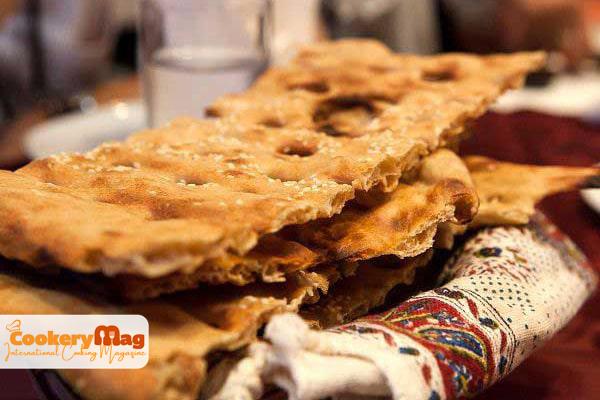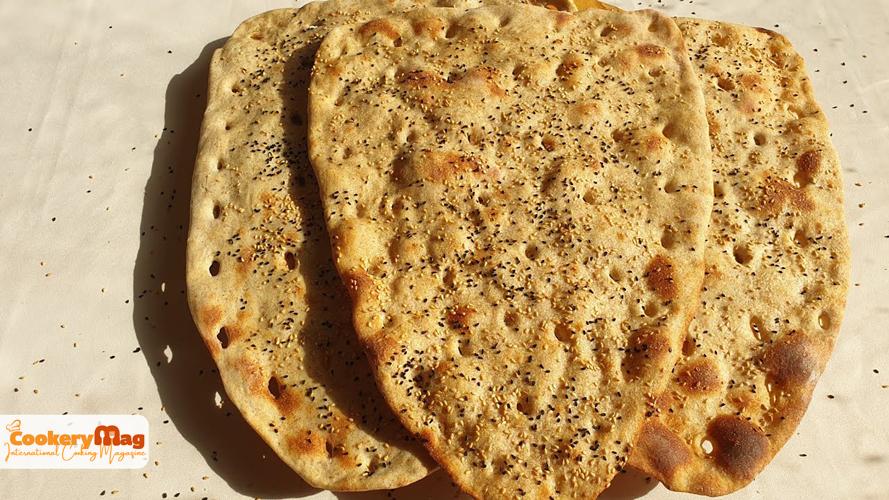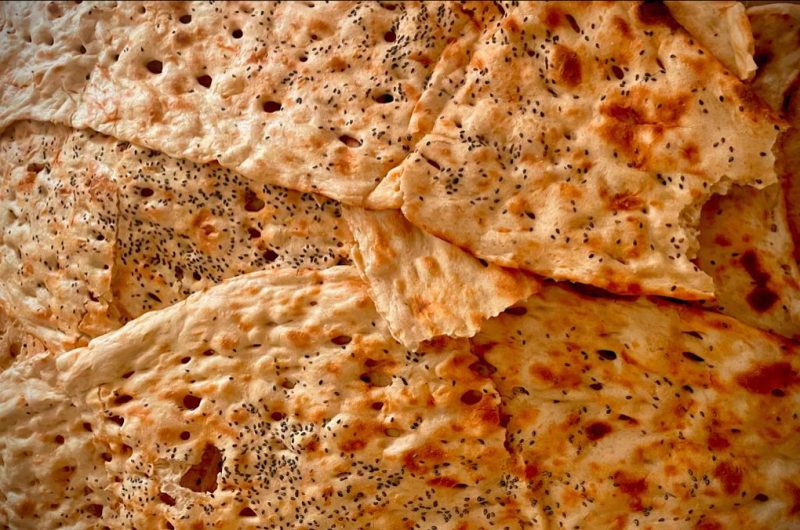© All Rights Reserved.
Sangak Recipe | Persian Flatbeard in 5 steps
Sangak Bread is a type of bread that is baked in a flat oven on a floor of pebbles or sand.
The history of baking sangak bread goes back to Iran. This kind of evolved bread is a nomadic bread that was cooked on fire and stones and was called komaj; follow us in Cookery Magazine for complete your information.
In the early period, Pahlavi was the most common bread in Iran, and this bread can be called the national bread of Iran. Sangak bread used to be the bread of the nobles and soldiers.
In the past, in some cities, sangak were seasonal bakeries; they were mostly baked in winter and Ramadan.
In the past, dried oven-baked bread was the most durable and long-lasting Iranian household bread, and it did not become stale for several months and remained healthy and tasty.
In the first half of the year, for the cold season, women would bake bread in the oven in the kitchen and dry it completely with gentle heat.
Ingredients for making Sangak
| Flour | 2 cups |
| Yeast | ½ tablespoon |
| Lukewarm Water | 2 cups |
| Salt | As much as needed “Preferably 2 teaspoons” |
| Butter | As much as needed |
| Sesame (or Nigella sativa as desire) | As much as needed |
Recipe for making Sangak
The first step of preparing homemade Sangak bread:
First, to start the work, we have to make the sourdough the night before, and for this purpose, we mix ⅓ of the flour with half a teaspoon of yeast.
Then, we add 1 cup of lukewarm water with an approximate temperature of 45 degrees Celsius and mix the ingredients together.
We cover the container with nylon so that the yeast rests in the kitchen environment for approximately 24 hours, and the sourdough is made. In addition to the environment, you can also rest it in the refrigerator.
The second step
Next, we mix the rest of the flour, lukewarm water, and some salt and mix them with a mixer until they are uniform.
After 24 hours, we take the sourdough out of the container and mix it into flour.
We add water and salt, mix the ingredients well, and knead. Then, we covered the bread dough with nylon and let the dough rest for 1 hour in the refrigerator.
The third step
Then we take an oven tray and put some clean and washed pebbles on its bottom, and place the tray with the pebbles in the oven at 180 degrees Celsius until the pebbles are well heated.
Then, leave a container of water next to you and take the Sangak bread dough out of the refrigerator after resting.

Note that this dough is loose, and you should use water to spread it and wet your hands. We spread the dough on a flat surface that we wet by splashing water.
The fourth step
Then we take the tray out of the oven, and when the pebbles are hot, we apply some butter or liquid oil on it with a brush so that the dough does not stick to the stones.
Then we spread the dough on the surface of the stone, poured some sesame seeds on it, and put the tray in the oven until it turned golden and cooked.
Then we took the tray out of the oven and turned the bread upside down so that the other side also cooked well and turned golden.
Then we take the bread out of the oven, and after it cools down, we remove the stones easily.
The fifth step of preparing homemade Sangak bread:
Now, our homemade Sangak bread is ready, and we use it for different dishes and breakfast or dinner.
I hope you like the recipe for this delicious bread and make Sangak bread at home whenever you feel like it.

Having a journey in the history of Nan sangak
Bakers are the men who stand next to the only triangular oven in the world and cook the oldest triangular bread in the world: Sangak!
Iran is unique in terms of the variety of bread, and in a few countries, the variety of bread and the amount of bread consumption reaches Iran.
One of the theories about the history of sangak bread is that sangak bread was popular in Iran before Islam, and after the illness of one of the Sassanid kings, the doctor ordered to prepare bread baked on the sand for the king.
In 1326, the head of the Tehran Bakers Committee wrote: Sheikh Baha’i invented Sangak bread at the request of Shah Abbas, and how this happened is as follows:
Shah Abbas, for the well-being of the poor classes and his soldiers, who often needed temporary and urgent bread and stew during the journey and needed to reach every city, should have bakers who could prepare enough bread for the soldiers’ consumption and food to put in bread stew.

He looked for a solution and asked “Sheikh Baha’i”, who was one of Iran’s scholars and scientists, to solve this problem.
Sheikh Bahá’í invented a stone oven with thought and meditation.
This invention, which was carefully planned and implemented, is so complete and precise that after several hundred years, it is still used in the same way as the original, and the bread obtained from the stone oven is the most suitable bread.
Conclusion
Thank you for being with us with this delicious and popular bread. If you have any questions, it’s my honor to answer. Enjoy your exploration of Persian cuisine!
Please share this article with your friends on Facebook, Twitter, Pinterest, and other social media. 🧡
Sangak Recipe | Persian Flatbeard in 7 steps
Course: Persian Food4
servings1
hour10
minutes300
kcalIngredients
Flour, 2 cups
Yeast, ½ tablespoon
Lukewarm Water, 2 cups
Salt, As much as needed “Preferably 2 teaspoons”
Butter, As much as needed
Sesame (or Nigella sativa as desire), As much as needed
Directions
- The first step of preparing homemade Sangak bread:
First, to start the work, we have to make the sourdough the night before, and for this purpose, we mix ⅓ of the flour with half a teaspoon of yeast.
Then, we add 1 cup of lukewarm water with an approximate temperature of 45 degrees Celsius and mix the ingredients together.
We cover the container with nylon so that the yeast rests in the kitchen environment for approximately 24 hours, and the sourdough is made.
In addition to the environment, you can also rest it in the refrigerator. - The second step
Next, we mix the rest of the flour, lukewarm water, and some salt and mix them with a mixer until they are uniform.
After 24 hours, we take the sourdough out of the container and mix it into flour.
We add water and salt, mix the ingredients well, and knead. Then, we covered the bread dough with nylon and let the dough rest for 1 hour in the refrigerator. - The third step
Then we take an oven tray and put some clean and washed pebbles on its bottom, and place the tray with the pebbles in the oven at 180 degrees Celsius until the pebbles are well heated.
Then, leave a container of water next to you and take the Sangak bread dough out of the refrigerator after resting.
Note that this dough is loose, and you should use water to spread it and wet your hands. We spread the dough on a flat surface that we wet by splashing water. - The fourth step
Then we take the tray out of the oven, and when the pebbles are hot, we apply some butter or liquid oil on it with a brush so that the dough does not stick to the stones.
Then we spread the dough on the surface of the stone, poured some sesame seeds on it, and put the tray in the oven until it turned golden and cooked.
Then we took the tray out of the oven and turned the bread upside down so that the other side also cooked well and turned golden.
Then we take the bread out of the oven, and after it cools down, we remove the stones easily. - The fifth step of preparing homemade Sangak bread:
Now, our homemade Sangak bread is ready, and we use it for different dishes and breakfast or dinner.
I hope you like the recipe for this delicious bread and make Sangak bread at home whenever you feel like it.
Frequently Asked Questions about sangak bread
Is it necessary to use sourdough in preparing homemade Sangak bread?
Yes, in fact, one of the differences between Sangak bread dough and other bread dough is the use of sourdough in preparing this bread.
Is it possible to reduce the resting amount of this dough in the preparation of Sangak bread dough?
No, Sangak bread dough requires long breaks in several stages, and this must be observed.
Is it possible not to spread the dough on pebbles when preparing sandak bread?
Sangak bread dough, as its name suggests, must be cooked on a hot stone, and the reason for its name is the use of stone in its baking; because the first part of its name which is u0022sangu0022 means stone in Persian language.
When making homemade pebble bread, after pouring the pebbles on the tray, do you have to grease them?
Greasing the stones is absolutely necessary because the Sangak bread dough is very sticky and loose, and greasing the stones reduces the stickiness of the dough. It can be easily removed after baking.


